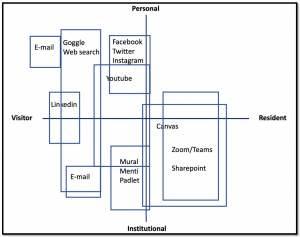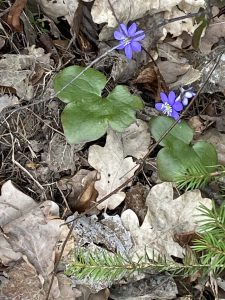So the course I’ve attended in Collaborative Learning in Digital Learning Environments has come to its end. It’s time to summarize and reflect on my learning and development.
My most important takeaways
One of my most important takeaways was early in the course when introduced to White & Le Cornu’s (2011) concept of Visitors and Residents on the internet. It was a relief to think of it in this way as opposed to Marc Prensky’s (2001) idea of Digital natives and Digital immigrants, divided by age by age only. Being a digital immigrant felt like I was never expected to contribute to my student’s digital literacy. And I will keep the diagram of visitors and residents in my mind and reflect on how my own identity is changing.
Then learning more about open educational resources was an eye-opener. At first, I thought of it as wishful thinking, but now I know it’s so much more. I will explore more of the resources available and incorporate them into my courses. When and if I’m pleased with modules in my courses, I will share them on canvas commons. And I will be more conscious in the way I use material from other sources, cleaning up a few presentations. A new open micro-course on Digital literacies for online learning will take me further on this path.
The third major takeaway is course design, but I’m still overwhelmed by all the input, theories, and ideas; I need time to sort it out and read more. The final assignment is on this subject. Teaching in Blended Learning Environments by Vaughan et al. (2013) and material by Terry Anderson and David Wiley are high on my to-read list.
The role of technology
I’m an engineer, so I like technology. I buy and subscribe to more tech stuff than I should from a sustainability perspective. However, I’ve dropped the OBS, stream deck, multiple cameras, multiple screens, a wireless mic, and a few other gadgets. It was honestly a hassle just to set everything up, and I felt it took some of my focus away from the students. And me being genuinely present seems to work better than anything else. I’m still thinking of getting a teleprompter to be able to look into the camera more. On the application side, I’ve tested many and found a few favorites so far, especially for collaboration. I’m now regularly using Padlet, Mentimeter, Mural, and a few more mapping tools and simulations specific to industrial management. I have more student activity and engagement with these tools than most things I’ve done on the campus. With a simulation that ran for an entire course, one of the most ambitious students commented that this was the first time he felt challenged and could dive deep into a subject. In the same simulation, a student with the ambition just to pass said – I could not keep myself away from it. I also found more students in a group participate, which then contribute to the group.
The journey continues
This course is about to end. I’m just two hours away from the deadline for this blog post, and I have already received one mail and one reminder for my course valuation. Once my own teaching ends for the summer holidays, I’ll review the course design material and complete the final written exam. We are to create a course plan using Gilly Salmon’s Five Stage Model (www.gillysalmon.com). I’m looking forward to spending time on this as it’s something I want to do with all the courses I teach. Courses should be continuously improved. I’m also excited for the new normal, and my courses are primarily campus-based; they will shift to hybrid and blended learning.
“Being a teacher is having a deep love of learning & want to pass that to others.”
@librarian_tiff




